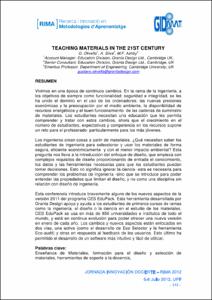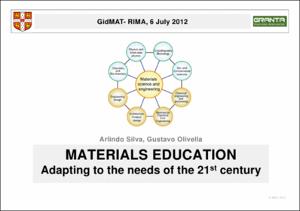Mostra el registre d'ítem simple
Teaching materials in the 21st century
| dc.contributor.author | Olivella, G. |
| dc.contributor.author | Silva, A. |
| dc.contributor.author | Ashby, M.F. |
| dc.date.accessioned | 2012-10-30T07:38:19Z |
| dc.date.available | 2012-10-30T07:38:19Z |
| dc.date.issued | 2012-07-06 |
| dc.identifier.citation | Olivella, G.; Silva; Ashby, M.F. Teaching materials in the 21st century. A: "Jornada d'innovació docent UPC: presentació de resultats dels projectes de millora de la docència". 2012, p. 212-225. |
| dc.identifier.uri | http://hdl.handle.net/2099/12662 |
| dc.description.abstract | We live in an era of continuous change. In the branch of engineering, beyond the usual and pressing objectives of functionality, safety and integrity, computers are now used pervasively, new economic pressures and concern for the environment are looming, and the availability of energy resources and proper functioning of materials supply chains are ever more important. Students need an education that allows them to understand and deal with these changes, in a time when growth in the number of students, expectations and pressure on teaching resources is a challenge for professors, particularly for younger academics. Engineers create things out of materials. What do engineering students need to know to select and use materials that perform as expected, are safe, economically efficient and have the least environmental impact? This question leads to the introduction of the design approach. Knowledge, data and tools are necessary for students to make decisions that meet complex design requirements. This means that science is introduced in a way that facilitates understanding how to meet design requirements and select materials and processes. This paper also introduces briefly some of the new aspects of the 2012 CES EduPack. This tool developed by Granta Design, supports professors and helps students of both introductory and advanced courses in branches such as engineering, design and science in the study of materials. CES EduPack is used in more than 850 universities and institutes around the world and is continually evolving to offer a new version each January. Changes and new features are focused on two pathways, one active (eg development of Eco Selector and Eco-audit tool) and another in response to feedback from users. The latter has made the software more intuitive and easy to use. |
| dc.format.extent | 14 p. |
| dc.language.iso | eng |
| dc.publisher | Universitat Politècnica de Catalunya. Institut de Ciències de l'Educació |
| dc.rights | Attribution-NonCommercial-NoDerivs 3.0 Spain |
| dc.rights.uri | http://creativecommons.org/licenses/by-nc-nd/3.0/es/ |
| dc.subject | Àrees temàtiques de la UPC::Ensenyament i aprenentatge |
| dc.subject.lcsh | Education, Higher -- Congresses |
| dc.subject.other | Innovació docent |
| dc.title | Teaching materials in the 21st century |
| dc.type | Conference report |
| dc.subject.lemac | Ensenyament universitari -- Congressos |
| dc.subject.lemac | Ensenyament -- Innovacions -- Congressos |
| dc.identifier.dl | B.2208-2012 |
| dc.description.peerreviewed | Peer Reviewed |
| dc.rights.access | Open Access |
| local.citation.author | Olivella, G.; Silva; Ashby, M.F. |
| local.citation.publicationName | Jornada d'innovació docent UPC: presentació de resultats dels projectes de millora de la docència |
| local.citation.startingPage | 212 |
| local.citation.endingPage | 225 |
Fitxers d'aquest items
Aquest ítem apareix a les col·leccions següents
-
2012 (juliol) [60]



